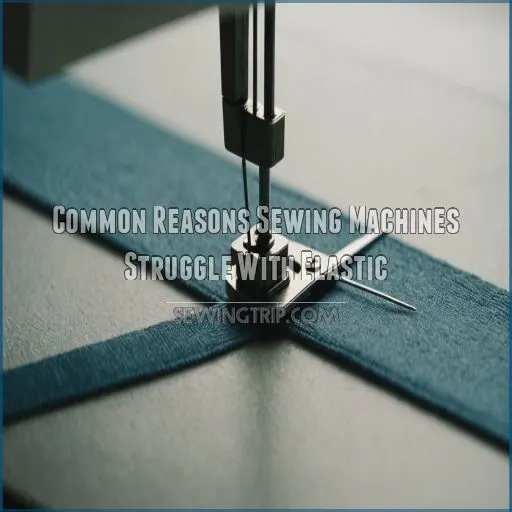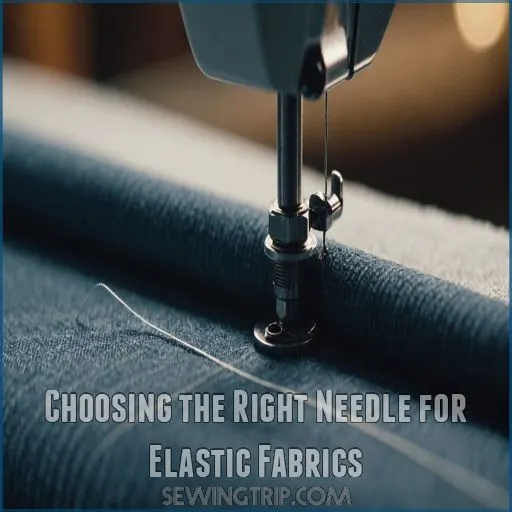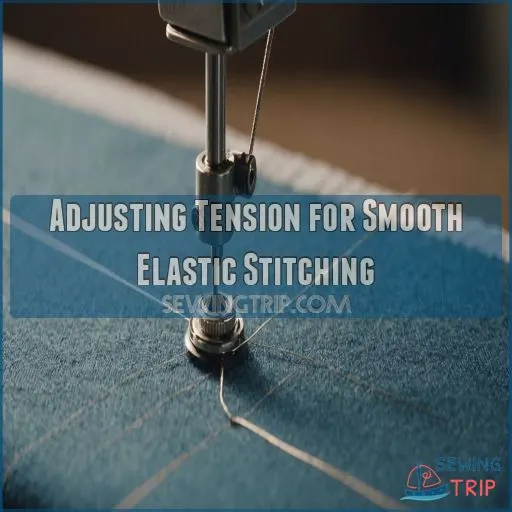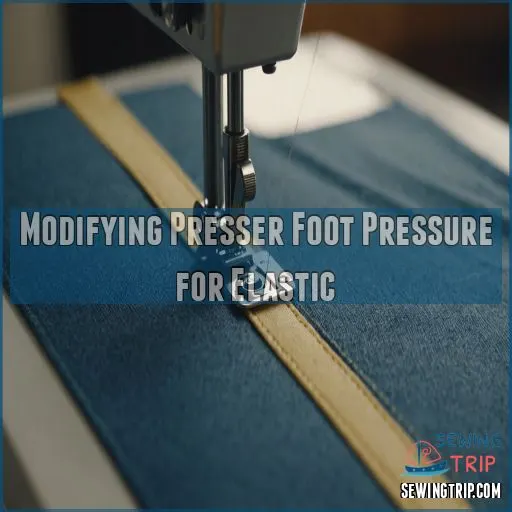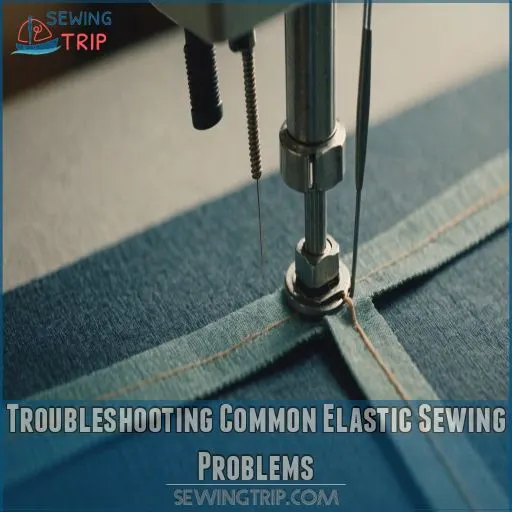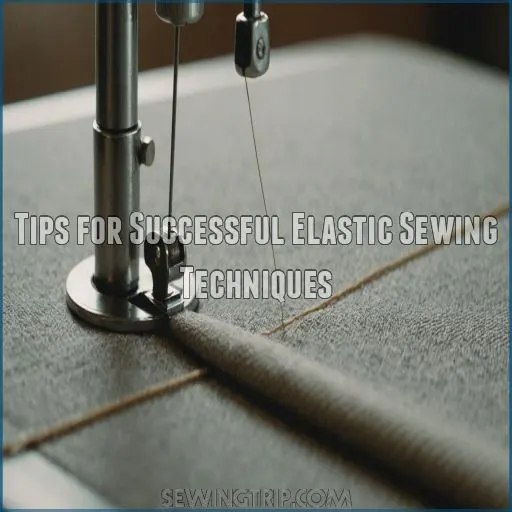This site is supported by our readers. We may earn a commission, at no cost to you, if you purchase through links.
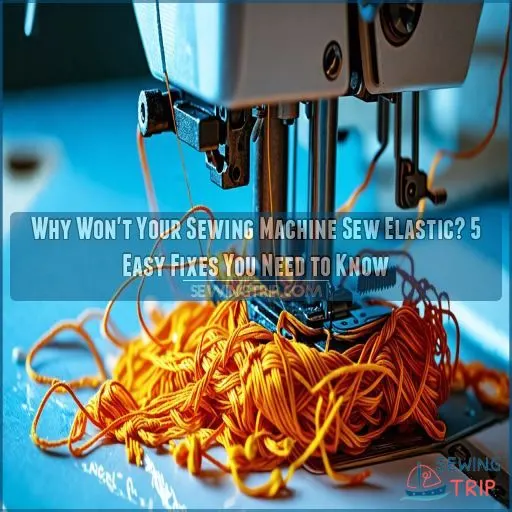
It’s like trying to wrangle a rubber band with a fork! The culprit’s often lurking in the wrong needle type – stretch fabrics need special treatment.
Tension settings could be off, causing your stitches to snap faster than a politician’s promises.
Your stitch choice might not have the flex factor elastic demands. Even presser foot pressure plays a part in this stretchy saga.
Don’t throw in the towel just yet, though. With a few tweaks, you’ll be stitching elastic like a pro. Stick around to unravel the secrets of smooth, stretchy seams.
Table Of Contents
- Key Takeaways
- Common Reasons Sewing Machines Struggle With Elastic
- Choosing the Right Needle for Elastic Fabrics
- Adjusting Tension for Smooth Elastic Stitching
- Selecting Appropriate Stitches for Elastic Materials
- Modifying Presser Foot Pressure for Elastic
- Troubleshooting Common Elastic Sewing Problems
- Tips for Successful Elastic Sewing Techniques
- Frequently Asked Questions (FAQs)
- Conclusion
Key Takeaways
- You’re not alone in your elastic-sewing struggles – it’s like trying to wrangle a rubber band with a fork! Switch to a stretch or ballpoint needle to glide through those stretchy fibers without a hitch.
- Think of tension as a tug-of-war between your upper and lower threads. Loosen up a bit for elastic – turn that tension dial down a notch or two, and watch your stitches dance in harmony.
- Ditch the straight stitch and embrace the zigzag – it’s your elastic-sewing superhero! This stretchy stitch flexes with your fabric, preventing puckering and snapped threads faster than you can say "wardrobe malfunction."
- Your presser foot isn’t a drill sergeant – ease up on the pressure to let that elastic breathe. It’s like finding the sweet spot on your car’s gas pedal, but for fabric. You’ll be cruising through stretchy projects in no time!
Common Reasons Sewing Machines Struggle With Elastic
Ever tried sewing elastic only to find your trusty machine throwing a fit?
From wonky needles to tension troubles, there’s a handful of culprits that can turn your elastic-sewing dreams into a stretchy nightmare.
Incorrect Needle Type
Needle nightmares got you in a stretch? Your sewing machine’s struggles with elastic might stem from using the wrong stretch sewing needles
.
Ditch those universal needles and opt for stretch or ball point needles . These smooth operators glide between elastic fibers without snagging or breaking threads.
Remember, size matters too – go for 75/11 for light elastics and 90/14 for heavier ones. The right needle can turn your elastic-sewing woes into wins and make sewing with elastics a smooth operator.
Improper Tension Settings
You’ve got the right needle, but your elastic’s still playing hard to get? Let’s talk tension, baby! It’s like a tug-of-war between your upper and lower threads. Too tight, and you’ll have a tangled mess. Too loose, and it’s a floppy disaster. Finding that Goldilocks zone is key (Source).
Here are three tension-taming tips:
- Start with your machine’s default settings
- Adjust upper thread tension if needed
- Fine-tune lower thread tension if needed
Unsuitable Stitch Selection
Even with perfect tension, your elastic might still be giving you the slip. The secret’s in the stitch!
Regular straight stitches just won’t cut it for sewing stretchy fabric
. Instead, become best friends with stretch stitches like the zigzag, overcasting, or triple zigzag.
These stitches are like yoga for your fabric – they’ll bend and stretch without breaking. Remember, different elastics need different stitches, so don’t be afraid to experiment on scraps first.
Inadequate Presser Foot Pressure
While stitch selection is key let’s not forget about the unsung hero presser foot pressure. It’s like Goldilocks – too much or too little, and you’re in for a bumpy ride.
Inadequate pressure can turn your elastic into a stretchy nightmare, warping your fabric faster than you can say "seam ripper."
Adjust that dial and watch your elastic behave like a well-trained puppy. Your sewing will thank you!
Choosing the Right Needle for Elastic Fabrics
Ever felt like your sewing machine and elastic were sworn enemies?
Choosing the right needle can turn that rivalry into a harmonious dance, with stretch needles leading the way to smooth, snag-free stitching.
Stretch Needle Benefits
For taming elastic fabrics, a stretch needle is your secret weapon.
These needles have a rounded end and longer thread loop, preventing snags and skipped stitches.
They’re perfect for lycra and spandex, but also work wonders on sweater knits and velour.
Think of them as your fabric’s best friend, smoothly gliding through stretchy materials like a hot knife through butter.
Your stitches will thank you, and think of them as your fabric’s best friend.
Tension Adjustment Tips
Now that you’ve got the right needle, let’s fine-tune your machine’s tension. It’s like finding the perfect balance on a seesaw!
You’ll need to adjust both upper and lower threads for elastic fabrics.
Here’s your tension adjustment cheat sheet:
- Lower your upper thread tension (try 1-3)
- Decrease bobbin tension for seam flexibility
- Test on scraps before diving in
- Gradually tweak until stitches look even
Remember, every fabric’s unique, so don’t be afraid to play around!
Thread Type Matters
Choosing the right thread can make or break your elastic sewing project.
You’ll want to opt for polyester or cotton-wrapped polyester threads. These types play nice with stretch needles, helping you avoid those pesky skipped stitches.
It’s also essential to pair your thread with the right needle, such as a ballpoint needle, which is perfect for smooth stitches on stretchy fabrics a smooth stitch guide.
Think of thread as your fabric’s dance partner – it needs to be flexible enough to keep up with elastic’s groovy moves. Additionally, using a thread with a bit of elasticity, like those designed for stretch fabrics, can help provide a comfortable fit.
Don’t let the wrong thread type trip you up on your sewing journey!
Adjusting Tension for Smooth Elastic Stitching
Is your sewing machine turning elastic into a tangled mess?
You’ll need to tweak your tension settings to get those stretchy stitches just right.
But don’t worry – it’s easier than trying to squeeze into last year’s elastic waistband.
Upper Thread Tension Adjustments
Your upper thread tension can make or break your elastic sewing game. Think of it as a tug-of-war between top and bottom threads.
For elastic, you’ll want to loosen up a bit – turn that tension dial down a notch or two. Start with a test run on scrap fabric.
If you see loops on top, tighten slightly. Bunching underneath? Loosen up, buttercup! It’s all about finding that Goldilocks zone.
Your thread tension adjustments are a balancing act, requiring patience and fine-tuning to achieve the perfect tug-of-war between threads.
Bobbin Tension Modifications
Let’s tackle the bobbin tension tango!
While you’ve fine-tuned the upper thread, don’t forget its dance partner below.
Think of bobbin tension as the Goldilocks of sewing – not too tight, not too loose, but just right.
A quarter turn of the screw can make a world of difference.
It’s like adjusting the strings on a guitar – small tweaks, big impact!
Testing Tension on Scrap Elastic
Now that you’ve tweaked your bobbin tension, it’s time to put it to the test. Choosing the correct needle size and type based on thread weight and type is really important, as described in the thread compatibility and needle size. Also, you need to think about material compatibility and pressure adjustment, like using a walking foot for stretch for stretch fabrics, to achieve smooth stitching
.
Grab a scrap of elastic fabric and examine a piece about the same width as your target fabric. You’re about to become a tension detective.
Sew a few rows and examine your handiwork. If you see squiggly lines, your tension’s too loose. Perfect rows? You’ve hit the jackpot! Keep stitching until you’re stitching like a pro.
Selecting Appropriate Stitches for Elastic Materials
You’ve got the elastic, but your sewing machine’s not cooperating?
Let’s talk stitches. Picking the right stitch can make or break your elastic sewing project, turning a potential wardrobe malfunction into a stretchy success story.
Zigzag Stitch Benefits
With tension set, it’s time to pick the perfect stitch.
The zigzag is your elastic-sewing superhero, much like it’s a great choice for sewing velcro strips with equal strength hook and loop tape.
It stretches with the fabric, preventing puckering and snapped threads.
Think of it as a mini-accordion, flexing as you move, much like the way a walking foot provides better control and stability when sewing through thick velcro strips why won’t my sewing machine sew velcro.
You can adjust both length and width to suit your project.
Plus, it’s a cinch to unpick if you need a do-over.
Talk about a stitch that’s got your back!
Triple Zigzag for Added Strength
The triple zigzag stitch takes your elastic sewing game to the next level.
It’s like the zigzag’s big brother, offering more stretch and durability for your projects.
You’ll love how it distributes tension across three points, reducing the risk of popped seams when your elastic is under stress.
It’s perfect for activewear, swimsuits, or anywhere you need extra oomph in your stretchy seams.
Overcasting Stitch Applications
You’ve mastered the triple zigzag, but let’s talk about the unsung hero of elastic sewing: the overcasting stitch.
This versatile stitch is your secret weapon for:
- Finishing raw edges without puckering
- Sewing and neatening stretch fabrics in one go using hand sewing techniques
- Creating a professional look on seam allowances
It’s like giving your elastic a comfy little jacket. With the right foot and settings, you’ll be whipping up stretchy masterpieces in no time.
Triple Stitch for Clean Seams
Ready to level up your elastic game?
Let’s talk triple stitch – your secret weapon for clean, strong seams.
Unlike zigzags, this stitch packs a punch with three parallel rows of stitching.
It’s like giving your elastic a superhero suit!
Adjust your tension slightly looser and reduce foot pressure for best results.
Remember, practice makes perfect – soon you’ll be stitching elastic like a pro, no problem, soon you’ll be stitching elastic like a pro, no problems, soon you’ll be stitching elastic like a pro.
Modifying Presser Foot Pressure for Elastic
Ever wonder why your elastic sewing projects come out wavy or stretched?
The secret’s in your presser foot pressure – it’s like finding the sweet spot on your car’s gas pedal, but for fabric.
Reducing Foot Pressure to Prevent Stretching
Taming elastic’s wild side starts with easing up on your presser foot. Don’t let it bully your fabric! Reduce the pressure to let your elastic glide through smoothly.
Here’s your game plan:
- Dial down the pressure to 1 for lightweight knits
- Bump it up to 2-3 for medium to heavy fabrics
- Consider a walking foot for ultimate control
Remember, less pressure means more flexibility. You’re the boss of that foot, so show it who’s in charge!
Using a Teflon Sewing Foot
Let’s kick things up a notch with a Teflon sewing foot! This slick operator glides over elastic like butter on a hot skillet.
It’s your secret weapon against stubborn stretch fabrics, preventing those pesky skipped stitches. The non-stick coating works wonders, letting you maintain control without cranking up the pressure.
It’s like giving your machine ice skates – smooth sailing all the way through your elastic adventures!
Walking Foot Benefits for Elastic Fabrics
Your sewing machine’s walking foot is like a magic wand for elastic fabrics. It keeps your stretchy material from doing the cha-cha while you sew.
Here’s why it’s a game-changer:
- Even fabric feed: Both layers move together smoothly
- Prevents bunching: Say goodbye to pesky puckers
- Improved stitch quality: Seams stay aligned, even on slippery knits
- Reduced stretching: Keeps your elastic from going rogue
Trust me, once you try it, you’ll wonder how you ever lived without it!
Troubleshooting Common Elastic Sewing Problems
Sewing elastic can turn your project into a tangled mess faster than you can say "thread nest."
Let’s unravel those pesky problems like skipped stitches, bobbin jumbles, and machine jams so you can get back to creating stretchy wonders without the headache.
Addressing Thread Nesting Issues
Thread nesting can turn your sewing project into a bird’s nest faster than you can say "bobbin."
Don’t panic! First, rethread your machine completely – it’s like giving it a fresh start .
Check your needle choice and tension settings.
If the problem persists, play detective and clean out any sneaky lint hiding in the tension discs.
Remember, patience is key when untangling this elastic enigma, it requires giving it a fresh start and being patient
Resolving Skipped or Entangled Stitches
Skipped stitches and entangled threads can turn your elastic sewing project into a real head-scratcher. Don’t worry, though – you’ve got this! To tackle these pesky problems:
- Check your needle
Fixing Bobbin Thread Jumbling
Ever feel like your bobbin’s throwing a tantrum? Don’t fret!
To tame that jumbling beast, start by re-threading your machine with the presser foot up.
Next, give your needle a once-over – a bent one can cause chaos.
If you’re still in a tangle, try adjusting the bobbin tension. Remember, it’s a delicate dance – small tweaks can make a big difference.
Preventing Machine Jamming
You’ve tamed the bobbin beast, but now your machine’s throwing a tantrum? Let’s nip that jamming in the bud!
Think of your sewing machine as a finicky chef – it needs the right ingredients to whip up elastic magic.
Here’s your recipe for smooth sailing:
- Choose a stretch needle that glides through elastic like butter
- Adjust foot pressure to give elastic room to breathe
- Set stitch length longer for a happy elastic dance
Tips for Successful Elastic Sewing Techniques
You’ve mastered the basics, now it’s time to level up your elastic sewing game.
These pro tips will help you tackle tricky elastic projects with ease, from choosing the right width to nailing that perfect seam allowance.
Proper Elastic Width and Length Selection
Picking the right elastic is like finding the perfect dance partner for your fabric.
Consider your project needs when choosing elastic types. Knitted or woven elastic works best for direct edge sewing, while braided elastic shines in casings.
Use a measurement guide to nail the perfect width and length. Don’t forget to factor in fabric weight and desired stretch level. It’s a balancing act, but you’ve got this!
Adjusting Seam Allowance for Elastic Movement
Now that you’ve selected the perfect elastic, let’s talk about giving it room to breathe. Adjusting your seam allowance is like giving your elastic a comfy stretch zone. Think of it as a dance floor for your stretchy friend!
Here are four key tips to nail that elastic-friendly seam allowance:
- Measure twice, cut once: Add an extra 1/4" to your usual allowance
- Go with the flow: Align seamlines for smooth movement
- Test drive: Stitch a sample to check stretch and recovery
- Fine-tune: Tweak allowance based on fabric type and desired fit
Sewing Elastic Directly on Edges
Ready to tackle elastic edge finishes? Let’s roll up our sleeves and get stitching!
Start by aligning your elastic with the fabric edge, leaving a sliver of fabric showing.
Use a zigzag stitch to secure it, pulling gently as you go to prevent puckering.
Remember, matching thread is your best friend here – unless you’re aiming for that "oops, I sewed in the dark" look!
Creating Casings for Elastic Insertion
With a bit of finesse, creating casings for elastic insertion can be a breeze. You’ll master this skill in no time, giving your garments that perfect snug fit.
Here’s your roadmap to casing success:
- Measure twice, sew once: Make sure your casing width is 1/4" deeper than your elastic
- Play hide-and-seek with seam allowances: Avoid pesky ‘pockets’ that can snag your elastic
- Embrace the "sausage principle": Give your elastic breathing room for the best stretch
- Channel your inner artist: Iron those folds for a clean, professional finish
Frequently Asked Questions (FAQs)
Why is my sewing machine not stitching stretchy fabric?
Like a dancer out of step, your machine’s skipping stitches on stretchy fabric.
You’re likely using the wrong needle.
Switch to a ballpoint or stretch needle that separates knit fibers instead of puncturing them, ideal for working with stretchy knit fabrics
.
You’ll be back in rhythm quickly.
What setting on sewing machine for elastic?
For sewing elastic, set your machine to a stretch stitch or narrow zigzag.
Lower the presser foot pressure and thread tension. Use a walking foot if possible.
Test settings on scraps first – it’s a stretch, but you’ll nail it!
What tension should I use for sewing elastic?
Imagine elastic as a tightrope walker, balancing between stretch and stability.
You’ll want to decrease lower thread tension for flexibility.
Aim for 3-8% stretch, adjusting based on elastic strength.
For strong elastic, try 8-9% on waist, 7-8% on legs.
What tension do you sew stretchy fabric on?
You’ll want to lower your machine’s tension when sewing stretchy fabric, such as jersey fabric techniques jersey fabric techniques
.
Typically, drop it to 1-3, compared to 3-5 for regular fabrics.
Test on scraps first, and consider reducing foot pressure too for better control.
How do I prevent elastic from bunching while sewing?
Picture smooth, taut elastic gliding under your needle.
To prevent bunching, use non-roll elastic or stitch through the casing in multiple places.
Stretch the fabric as you sew, and distribute it evenly along the elastic .
You’ll master this in no time!
Can I use regular thread for sewing elastic?
Regular thread works for sewing elastic, but it’s not ideal.
Use shirring elastic in the bobbin for better results (Source).
It’s like pairing a dynamic duo – regular thread up top, elastic magic down below.
Experiment to find your perfect stretch!
Whats the best elastic width for different projects?
Who knew elastic could be so picky?
For pants, 3/4" knit elastic reigns supreme, offering comfort without the squeeze.
Skirts? Go bold with 2-3" for a smooth waistline.
Lightweight fabrics love 1/2" elastic, perfect for breezy summer projects.
How do I maintain my machine after sewing elastic?
After sewing elastic, clean your machine thoroughly. Remove stray threads and lint, especially from the bobbin area.
Oil moving parts if needed.
Check needle condition and replace if bent. Adjust tension back to normal settings .
Are there alternatives to elastic for stretchy seams?
Did you know 75% of sewers use alternatives to elastic?
You’ve got options! Try clear elastic for its recovery, power net for versatility, or fusible interfacing for ease.
Each has pros and cons, so pick what suits your project best.
Conclusion
So there you have it, folks! No more wrestling matches with your elastic – you’ve got the know-how to conquer those stretchy situations.
Remember, the right needle and the right approach can work wonders. Don’t let your sewing machine throw a fit; show it who’s boss!
With these tricks up your sleeve, you’ll be stitching elastic like a seasoned pro in no time.
Why won’t your sewing machine sew elastic? Now you know it’s not being stubborn – it just needed a little TLC and the right approach.

